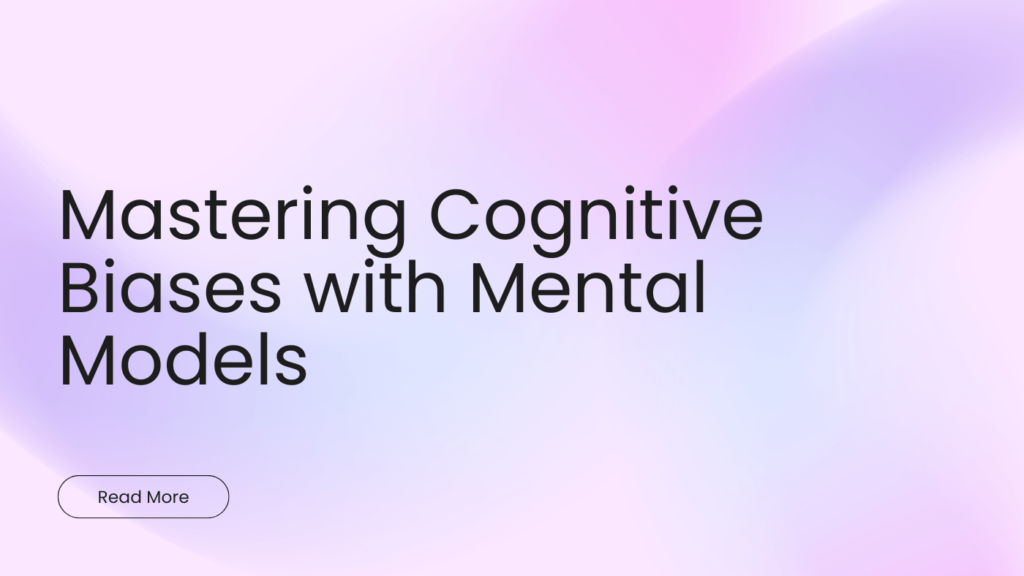Mastering Cognitive Biases with Mental Models: A Guide to Better Thinking
We all strive to make rational decisions, yet our minds are often tripped up by systematic errors in thinking called cognitive biases. These biases can lead to poor judgment, flawed reasoning, and suboptimal outcomes in both our personal and professional lives. Fortunately, there’s a powerful antidote: mental models. This comprehensive guide explores how leveraging mental models can help you understand, anticipate, and overcome cognitive biases with mental models, ultimately leading to clearer thinking and improved decision-making.
Understanding Cognitive Biases: The Invisible Traps in Our Minds
Cognitive biases are unconscious, systematic errors in thinking that affect the decisions and judgments people make. They arise from our brain’s tendency to simplify information processing, relying on mental shortcuts (heuristics) to make quick decisions. While these shortcuts can be helpful in some situations, they often lead to distorted perceptions and irrational choices.
Some common and impactful cognitive biases include:
- Confirmation Bias: Seeking out and interpreting information that confirms pre-existing beliefs, while ignoring contradictory evidence. (Nickerson, R. S. (1998). Confirmation bias: A ubiquitous phenomenon in many guises. *Review of General Psychology, 2*(2), 175-220.)
- Anchoring Bias: Over-relying on the first piece of information received (the “anchor”) when making decisions. (Tversky, A., & Kahneman, D. (1974). Judgment under uncertainty: Heuristics and biases. *Science, 185*(4157), 1124-1131.)
- Availability Heuristic: Estimating the likelihood of an event based on how easily examples come to mind. (Tversky, A., & Kahneman, D. (1973). Availability: A heuristic for judging frequency and probability. *Cognitive Psychology, 5*(2), 207-232.)
- Loss Aversion: Feeling the pain of a loss more strongly than the pleasure of an equivalent gain. (Kahneman, D., & Tversky, A. (1979). Prospect theory: An analysis of decision under risk. *Econometrica, 47*(2), 263-291.)
- Bandwagon Effect: Adopting beliefs or behaviors simply because many other people do.
- Dunning-Kruger Effect: Individuals with low competence in a subject overestimate their ability. (Kruger, J., & Dunning, D. (1999). Unskilled and unaware of it: How difficulties in recognizing one’s own incompetence lead to inflated self-assessments. *Journal of Personality and Social Psychology, 77*(6), 1121-1134.)
- Hindsight Bias: The tendency to believe, after learning an outcome, that one would have foreseen it.
These are just a few examples, and the list of cognitive biases is extensive. Recognizing that these biases exist and understanding how they operate is the first crucial step toward mitigating their influence.
What are Mental Models? Building Your Cognitive Toolkit
Mental models are simplified representations of how things work. They are frameworks for understanding the world, predicting outcomes, and making decisions. Think of them as tools in a cognitive toolkit that you can use to analyze situations from multiple perspectives.
Some valuable mental models include:
- First Principles Thinking: Breaking down a problem to its fundamental truths and reasoning up from there. Elon Musk famously uses this approach.
- Second-Order Thinking: Considering the consequences of the consequences. “What happens after that?”
- Inversion: Solving problems by thinking about the opposite of what you want to achieve. “How can I make this *worse*?”
- Occam’s Razor: The simplest explanation is usually the best.
- Systems Thinking: Understanding how individual parts interact within a larger system.
- Game Theory: Analyzing strategic interactions between individuals or entities. (von Neumann, J., & Morgenstern, O. (1944). *Theory of games and economic behavior*. Princeton University Press.)
- The Map is Not the Territory: Recognizing that a model is just a representation of reality, not reality itself.
The more mental models you have in your repertoire, the better equipped you are to analyze complex situations and make sound judgments. Charlie Munger, Warren Buffett’s longtime business partner, is a strong advocate for building a “latticework of mental models” to improve decision-making.
Overcoming Cognitive Biases with Mental Models: A Practical Approach
The real power comes from combining an awareness of cognitive biases with the application of relevant mental models. Here’s how you can overcome cognitive biases with mental models:
- Identify the Potential Biases: Before making a decision, actively consider which cognitive biases might be influencing your thinking. For example, if you are evaluating a new investment opportunity based on recent market performance, be aware of the availability heuristic.
- Select Relevant Mental Models: Choose mental models that can help you counteract the identified biases. In the investment example, you might use “Regression to the Mean” (recognizing that exceptional performance is unlikely to continue indefinitely) or “Base Rate Neglect” (considering the overall historical performance of similar investments).
- Apply the Mental Models: Actively use the chosen mental models to analyze the situation from different angles. Ask yourself: What are the underlying assumptions? What are the potential second-order consequences? What would happen if I approached this from the opposite perspective (inversion)?
- Challenge Your Assumptions: Mental models can help you question your existing beliefs and assumptions. This is particularly helpful in combating confirmation bias. Actively seek out information that contradicts your views.
- Seek Diverse Perspectives: Talk to people who have different backgrounds, experiences, and perspectives than you do. This can help you identify biases that you might have missed.
- Iterate and Learn: Reflect on your decisions and the outcomes that resulted. Did you successfully mitigate the influence of cognitive biases? What could you have done differently? Continuously refine your understanding of biases and your application of mental models.
Examples in Action
Let’s look at a couple of practical examples:
Example 1: Overcoming Confirmation Bias in Hiring
Bias: A hiring manager has a strong gut feeling about a candidate based on a brief initial interaction (e.g., they attended the same university). This could lead to confirmation bias, where the manager selectively focuses on positive information about the candidate while downplaying any weaknesses.
Mental Models:
- Inversion: What would make this candidate a *bad* hire? Focus on identifying potential red flags.
- Second-Order Thinking: What are the long-term consequences of hiring this person, both positive and negative?
- Systems Thinking: How will this person fit into the existing team dynamics and company culture?
Action: The hiring manager deliberately seeks out negative feedback about the candidate from other sources. They also consider how the candidate’s skills and personality will interact with the existing team. By actively challenging their initial positive impression, the manager can make a more objective assessment.
Example 2: Avoiding the Sunk Cost Fallacy in Project Management
Bias: A project is significantly over budget and behind schedule. The team is tempted to continue investing resources simply because they’ve already invested so much (“sunk cost fallacy”).
Mental Models:
- First Principles Thinking: What is the *actual* value we expect to derive from completing this project? What is the *minimum* resources required to achieve that value?
- Opportunity Cost: What else could we do with these resources if we abandoned the project?
- Loss Aversion (mitigation): Frame the decision as choosing between two future scenarios (continuing vs. abandoning) rather than dwelling on past investments.
Action: The project team objectively evaluates the potential return on investment for completing the project, ignoring the sunk costs. They also identify alternative projects that could generate a higher return with the same resources. By focusing on future opportunities rather than past investments, they can make a more rational decision about whether to continue the project.
Building a Mental Model Library: Continuous Learning and Application
Developing a robust mental model library is an ongoing process. Here are some tips for expanding your cognitive toolkit:
- Read Widely: Explore books and articles from diverse fields, including science, history, psychology, economics, and engineering.
- Take Notes and Summarize: Actively process the information you consume. Summarize key concepts and principles in your own words.
- Practice Applying Models: Look for opportunities to apply mental models to real-world situations. The more you practice, the more intuitive they will become.
- Review and Refine: Regularly review your mental model library and refine your understanding of each model. Add new models as you encounter them.
- Share and Discuss: Talk to others about mental models and their applications. This can help you deepen your understanding and identify new perspectives.
Conclusion: Towards More Rational and Effective Thinking
Mental models and cognitive biases are two sides of the same coin. By understanding the inherent flaws in our thinking and proactively applying relevant mental models, we can significantly improve our decision-making abilities. Overcoming cognitive biases with mental models is not a one-time fix, but rather a continuous process of learning, reflection, and application. By investing in this process, you can unlock your cognitive potential and make better choices in all aspects of your life.
Start today by identifying a cognitive bias you struggle with and researching a relevant mental model to help you overcome it. The journey towards more rational and effective thinking is a lifelong pursuit, but the rewards are well worth the effort.
“`


